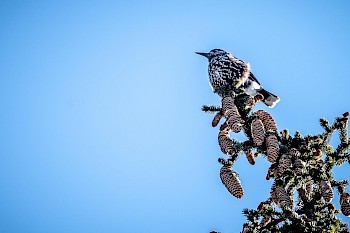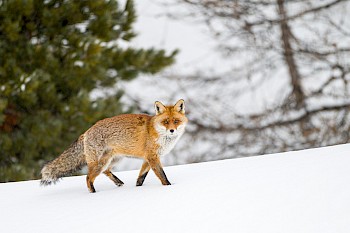Forest
Forest land : a "green lung" of extraordinary richness for both the flora and the fauna that live between the undergrowth and the treetops.
THE GUARDIANS OF THE FOREST
Watching & acting: The ONF
Nearly 25% of La Plagne consists of communal forest land (3500 hectares, the equivalent of the Bois de Vincennes and the woods at Disneyland Paris combined!), to which we can add the many privately-owned forests that are harder to estimate but which double this surface.
For several years now, in addition to its traditional missions, the ONF (National Forestry Commission) has been carrying out a vigilant health watch because of global warming. The Tarentaise forest -including the area of La Plagne – is doing well, which is fortunate because this is far from being the case of all of France’s forests. To observe the signs of this good health in La Plagne, you must go into the forest and look down at the ground.
Far from being as ordinary as it might seem, the ground is actually one of the best indicators of the state of the forest. Thanks to sectors that are hard to get to, the preserved undergrowth is full of life: a permanent virtuous and regenerative cycle between the earth and a whole “Microcosmos"-style universe that flourishes in the humus. In order to prevent the dramatic events that are observed elsewhere in France, like the disappearance of certain species, the ONF is part of a coherent and preventive proactive movement: forest maintenance, checking and managing of cohabitation between the different users (tourism, farming, etc.), diversification of tree species, numerous new plants and an ongoing collaboration with the Environmental Observatory
The winter season does not put a stop to the ONF’s activity, indeed far from it. The staff concentrate on surveillance and monitoring of the forest, including a survey of avalanches. Work is also carried out on implementing future projects.
Véronique de Righi, ONF regional manager for the Moutiers Territorial Unit
"In La Plagne, projects flourish regularly. We work with the SAP, which has a policy of reforestation and reducing the number of pylons (253 pylons removed since 2006)."
Moving species for better protection: the Environmental Observatory
Both discreet and scientifically rigorous, the actions of the Environmental Observatory, created in 2014 by the SAP (Société d'Aménagement de la Plagne- the ski lift company) are concretely implemented in the field. Amongst other things, these include moving species ahead of development projects.
This is the case, for example, of the Solitaire butterfly and its host plant, the marsh cranberry. In concrete terms, specialist ecologists come to the site before the work commences to check for the presence of butterflies in the form of eggs or caterpillars. If they find them, they move them to a favourable location away from the worksite. Once this has been done, the host plants (on which the butterflies lay their eggs and develop) can also be moved away from the worksite. The aim of the operation is to preserve an equivalent "habitable" surface for that species of butterfly so as not to endanger the survival of the fragile insect.
SECRET FOREST
Remarkable habitats to discover with a guide
La Plagne has several protected sectors that shelter fauna and flora that are both exceptional and endemic. Some of these sectors can be visited during guided hikes. The guides play a fundamental role in ensuring good cohabitation between hikers and the forest. They are the guarantee of good practices, such as staying on the paths, walking in single file and respecting the calm of the site…
Three examples of remarkable habitats:
- Mont-Saint-Jacques where the timid black grouse lives year round. In winter, this pretty gamebird (also called a ‘blackgame’) builds… an igloo. However, if it is disturbed by skiers, the bird leaves its winter home and does not survive. The black grouse is not a protected species, but it is an "umbrella" species that other species depend on directly to survive. An ecosystem with a fragile balance that absolutely must be preserved.
- wetlands that are nearly invisible if you are not attentive, can be found almost everywhere in La Plagne, in or close to the ski area: they are sensitive natural environments that are subject to regular ecological diagnoses. Around 120 hectares can be found in La Plagne, including Carella plateau next to the chairlift, or the Lac Noir peat bog in the Montchavin-Les Coches sector.
- another example of a remarkable habitat is the stone pine grove on gypsum, where the renewal of the stone pine only comes about because of the absent-mindedness of the speckled nutcracker which forgets where it has hidden its seeds. A natural treasure in the heart of the ski area, 2000 m above sea level, which can be visited on snowshoes.
Did you know?
Protected species:
- Lady’s Slipper flower
- ibex
- Bechstein’s bat
- most of the avifauna (i.e. the birds), from chickadees to birds of prey
Unprotected species:
- Edelweiss
- Marmots
- Black grouse
- Bovids, including chamois
- Wild boar
 La Cembraie
La Cembraie
Its characteristic landscape is shaped by hundreds of sinkholes where Swiss pine and larch trees grow. 12 ha of extremely rare geological and natural formations in the ski area. The result of an equation that is unique worldwide, this ecosystem combines gypsum soil and an equilibrium that rests on the delicate wings of a specific bird.
The spotted nutcracker is the keystone
Reforestation actually depends on the spotted nutcracker’s stock of Swiss pine cones. This bird hides the seeds in different places and then finds them again in the winter. However, it has not mastered this treasure hunt perfectly and sometimes forgets some, which can then germinate.
 A fragile balance
A fragile balance
Its situation in the middle of the ski runs requires our full attention to guarantee its sustainability and the harmony of the ecosystem. The area is ZNIEFF listed (Natural Area of special Ecological, Faunistic or Floristic Interest) but this does not mean that it is an impenetrable sanctuary.
